As an Amazon Associate I earn from qualifying purchases.
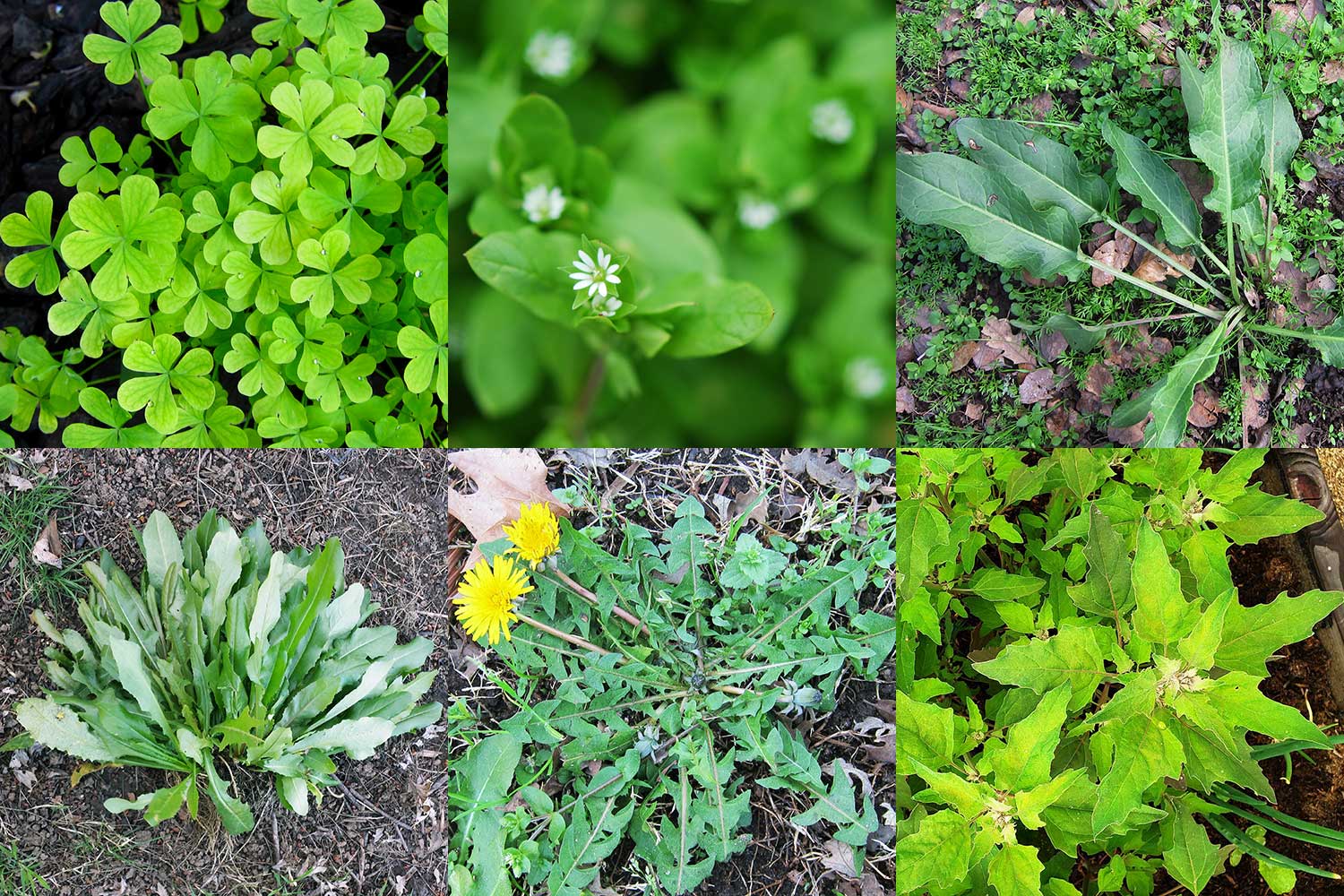
I admit it. I am a lawn-eater. Or to be more specific, I am an eater of those plants that live among the grasses which most people call “weeds.” Hurumph. Edible weeds are simply plants growing where you don’t want them to — any gardener will tell you volunteer tomatoes are weeds.
Spring, especially this strange spring, is the time to venture out on that most intimate of foraging trips — your yard — in search of edible weeds. The weather is still cool, but the sun is shining long enough that many wild plants are thinking of spring. And spring brings flowers. Time is ticking, because most lawn edibles are not very tasty once they flower.
I know, I know. Many of you live in colder climates and the very image of lovely spring greens in March is setting you on edge; it’s because you’ve been eating too many rutabagas and turnips. Hang in there, though, because your time will come soon enough.
Fun fact of the day: Most typical yard weeds are European migrants that arrived with settlers, and most are eaten back in the Old Country — or at least someone’s Old Country.
Pretty much everyone knows about dandelions, right? I mean you can even buy them in a store. I see them at the produce section of Raley’s and smile. $1.99 a bunch? How about free, suckers? I have several dozen dandelions growing in my yard at any given time. Not enough to make a proper dandelion wine — you need a field full for that — but more than enough for some bracing salads.
Living alongside these wild chicories are the wild lettuces. Californians can see them flowering already — these are the ones with the little white flowers. Longer leaves with fewer serrations, and a little less bitter than the dandy leaves.

Foraging for Wild Greens: Dandelions, Wild Lettuces, Chicories
Everything you need to know about the dandelion and dandelion-like edible weeds you have in your yard.
Read MoreThe ideal time to collect yard greens is after a series of cool rains followed by some sunshine. Nights should still be cold, and days not beyond 70°F.
Basically, when picking wild salad greens, if it looks more or less like a dandelion or escarole leaf and it is growing in a rosette in your yard, it’s probably edible. Pick a leaf and take a bite. It should be a little bitter, but not overpoweringly so. Pull the whole plant if you can — that way you get your weeding done at the same time you are preserving the leaves.
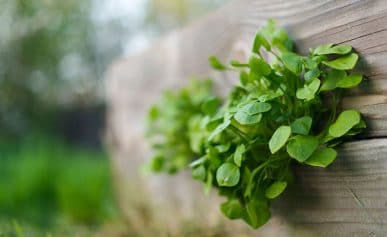
Foraging Miner’s Lettuce, America’s Gift to Salad
Live in the West? Chances are you have miner’s lettuce growing near you. Here’s how to identify this amazing wild salad green.
Read MoreAnother common lawn denizen is chickweed. Mouse ear chickweed is the lettuce of your lawn. Mild, pretty and slightly crunchy, it can grow in great masses. Clip these off and cut the stringy chickweed to about the length of your thumb; they’ll be easier to eat.
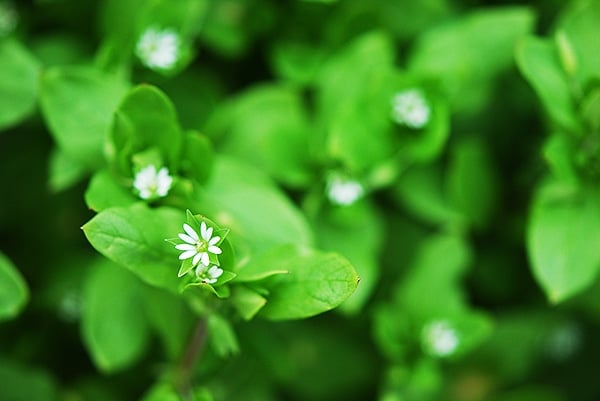
Depending on where you live, there are other lawn weeds to add to your foraged salad. Back East, wild onions and garlic grow everywhere: They look like little clumps of chives. By all means use them, and by so doing make me jealous — we don’t have any here. Wah.
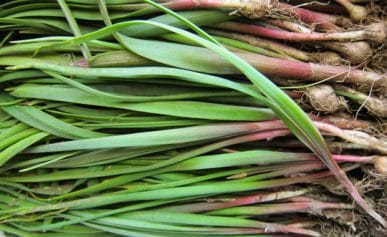
How to Harvest Wild Onions
From lawn onions to three-cornered leeks, many wild onions live in or near lawns and overlooked places.
Read MoreCresses are another good idea. I have a tiny little cress growing wild in my yard that I can’t get enough of its mustardy taste; I think it is Pennsylvania bittercress, but, eaten in winter, it is not so bitter. Most people have some sort of cress living near them, so keep an eye out.
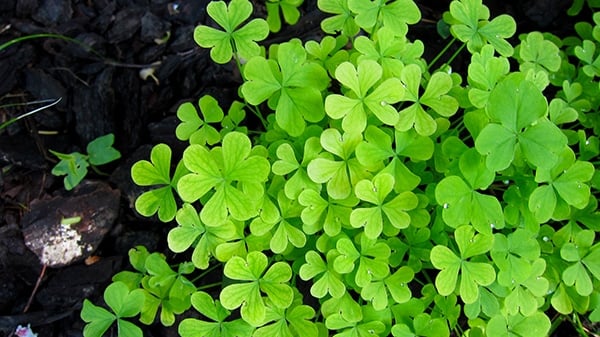
Sorrel is another common migrant. I have European sorrel growing in my yard, because I planted it and the seeds have since naturalized. But there are also the smaller sheep sorrel and wood sorrel, which grows all over the place — all varieties taste like lemonade in a leaf: sour and crunchy.
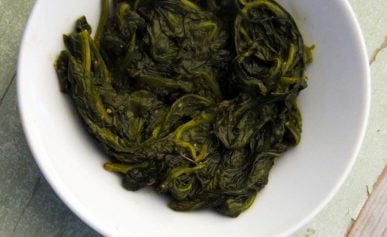
Gathering Curly Dock
Another very common edible weed, curly dock and it’s cousins add a little tang to your salad or saute. Here’s how to find and use it.
Read MoreSome areas also have wild violets or Johnny Jump-Ups, which are completely edible. A few violet flowers on your salad spruces up things nicely.
I’ve seen all kinds of other things in yards, too. Wild mustards (look for the four-petaled yellow flowers), wild mints and other herbs, and here in California, you can sometimes see wild fennel — with its anise aroma and frilly fronds, it is unmistakable. I use it a lot in spring.
(If you are wondering how to properly identify all these plants, I’ve linked to some of my favorite foraging books below. They should have all the information you need.)
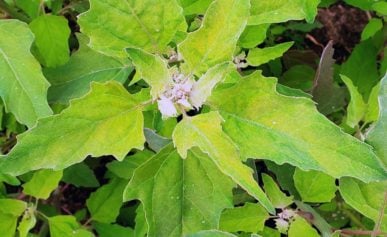
All About Lambsquarters, or Huauzontles
Once the weather gets warm, look for lambsquarters, which is a spinach cousin. In Mexico they call it huauzontles.
Read MoreVetch, a kind of bean, can take over certain places — it is a good indicator that your soil needs nitrogen — and can become a nuisance. You can make vetch work for you my clipping the last few inches of the growing tip and eating them like pea shoots. You can put the most delicate vetch tips in a salad, or briefly saute them in olive oil.
The brief saute is my the second go-to preparation for lawn-foraged greens. Older dandelion, curly dock leaves, wild mustard leaves and even filaree, also known as stork’s bill, can all go into the pot for a quick dance with hot olive oil, salt, garlic, a little chile and a squeeze of lemon.
Once cooked this way, you can also wrap your edible weeds up in phyllo dough for a kind of Greek spanakopita. For an Italian take, gather your greens and make a green minestrone with them — use lots and lots of green things, cooked for varying lengths of time, using my minestrone recipe as a base.
I’ve made a cool pesto with nettles or dandelion leaves, too. Just sub in dandelions for basil in your favorite pesto recipe. It results in a zingy, slightly bitter pesto that really backs up mild meats like chicken or pheasant.
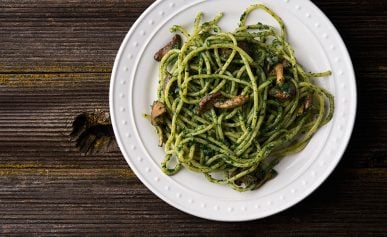
Nettle Pesto
Nettles lurk around the edges of many yards, and along many streamsides. Here’s how make a great pesto from them.
Read MoreMy final ritual in this early “spring cleaning” is to scour my garden for strays, holdovers and volunteers. Chervil, Italian chicories, overwintering lettuces, the ends of fava beans, the tops of green garlic or onions, etc., etc., etc. These add yet another dimension to your salad or saute and clean up your garden beds, too. Remember that even a wanted plant growing in the wrong spot is a weed, so be cruel when you have to in the garden beds.
Foraging edible weeds need not be some big production. So long as you don’t regularly douse your yard with chemicals, you can make quite a few meals from the vagrants and migrants that have set up shop among your prized bluegrass. And the best part? They’re free.
FAVORITE FORAGING BOOKS
You will want to go over to this page, which has a comprehensive breakdown of my favorite foraging books. But for this post especially you will want to pick up Ellen Zachos’ Backyard Foraging: 65 Familiar Plants You Didn’t Know You Could Eat, which covers lots of common landscaping and backyard edible plants.
The Quarantine Chronicles
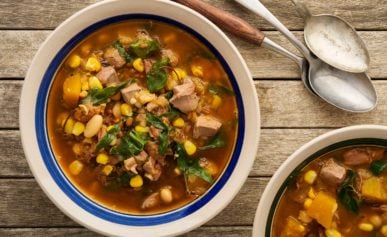
Making Stew with What You Have
Sometimes you have to make substitutions these days, and there is no better place to freestyle than in the stewpot. Here’s how to build a better stew.
Read More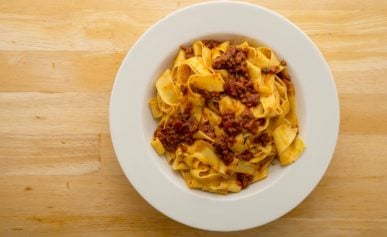
Black Mood, Red Sauce
It hasn’t all been sunshine and light these days. Our little family suffered a death recently, and its inevitability turned me inward, to that dish that gives me solace when all around me is black.
Read More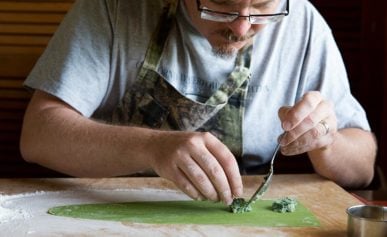
Stretching in Place
Quarantine has been a great opportunity to stretch yourself mentally, physically, and culinarily. Here are some ideas for you.
Read More
Time and Place on a Plate
When you can get out into the world again, do so with new eyes. Seeing what is around you when you hunt, fish or gather can inspire beauty on the plate.
Read More
Wasting Less, Living Better
Being thrifty in these times is a necessity. Here’s how I stretch and innovate in the kitchen using what I have handy.
Read More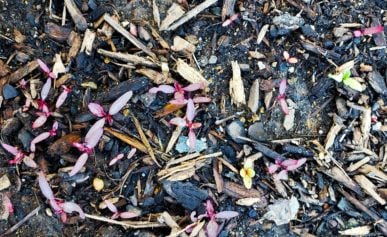
Support the Volunteers
In the garden, which for many of us is a place of solace these days, you will often find useful plants just growing, here and there. Consider supporting them.
Read More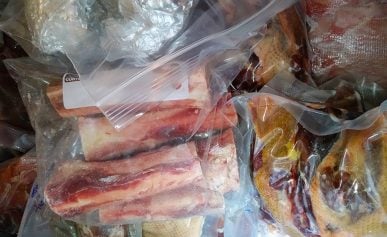
How to Salvage Freezer Burned Meat
When you can’t go to the store that often, you look into the depths of your freezer. Sometimes you don’t like what you see. Here’s how to deal with ancient frozen bits.
Read More

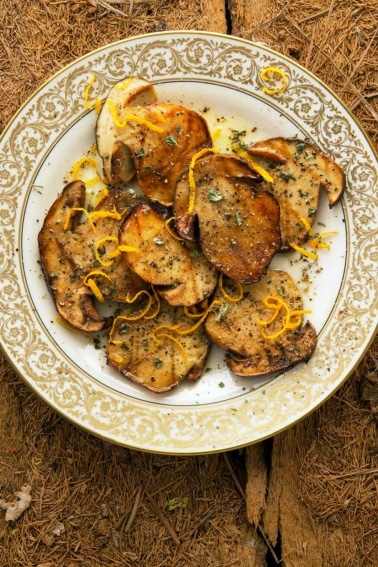
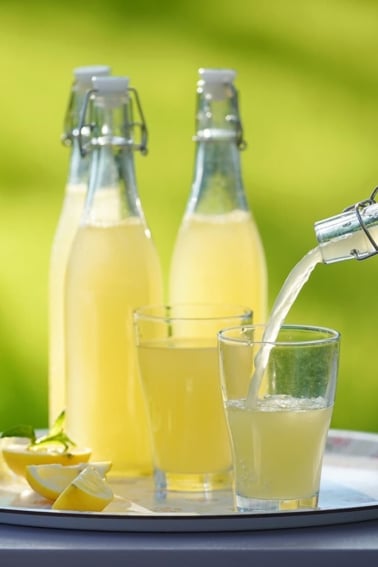
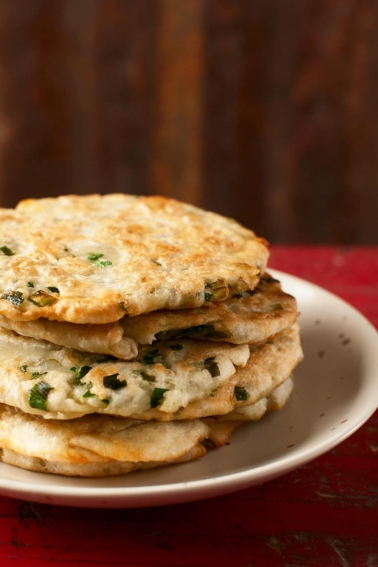
I will definitely be trying this out on my friends and family thank you for the ideas ?
Not only does eating your lawn give you great nutrition, & taste, but it causes you to use no pesticides and fertilizers, which is good for your pets. My stupid neighbors have a crayon-green lawn and no weeds and a gardener that comes more than once a week. Their dog died young of cancer. They grieved, got a new dog and still have those yellow warning flags on their lawn. Other neighbors have “green” gardeners that use no damaging chemicals, but I think that when weeds come they sneak an application of chemicals on it. It’s not normal to have a crayon green lawn with no weeds.
i need to know if this green in my yard is safe to eat?
Not sure if you will see this, Hank, since the post is old, but I used to line cook in Bandon, Oregon and my chef used to work for Nick. Small world!
Buzzie: LOVE those garlic chives. I miss them a lot.
My Spatula: Don’t worry, they’ll come back! 😉
Nate: Yes they are. Just don’t eat giant bowls of them every day, or you could get kidney stones.
mbe: Spring will be here in a moment…
Sylvie: Orach and lamb’s quarters are more of a late spring thing for us, and purslane is a summer weed.
don’t forget pigweed (lamb’s quarter) and purslane – at least on the East Coast. Both good for salad. Lamb’s quarters can also be lightly cooked, and purslane is tasty pickled. Are they naturalized in California like they are for us?
What a fantastic post! I can’t wait for spring to arrive in Vancouver so I can eat a nice salad like this.
Are Oxalis leaves edible?
Since you are using foraged weeds in your salad, would you like to enter this post in our Grow Your Own roundup this month?
damnit! my husband and i just spent the entire weekend weeding our entire garden and putting everything in the yard waste bin!
Hank–
Sorry for the confusion! No, we don’t have nettles in our yard, it’s way too dry. But I first started foraging (for dandelions) in the front yard–hence my husband’s teasing–and branched out from there…to the woods, to nettles and other good greens…
Great post!
Funny how some people don’t trust what they can eat in their front or back yards, but will go and buy dandelion greens in a store.
The wild garlic chives are a favorite flavoring for us in the spring and they are everywhere in our yard – so we gotta love ’em and use ’em. We’ll make a green dressing out of them puréed with olive oil (soon I hope)! It’s a false Spring day today. Snow is still on the ground but crocus are showing their greens and the sun is brilliant.
Tovar: I usually don’t get lamb’s quarters until it is far warmer, but they are one of my favorites. Warm-weather spinach!
Deana: Heard about that guy — Euell Gibbons was the first person I know of to do that, back in the 1950s.
CH: You have nettles in your yard? Wow. Must be wet there…
Matt: Thank Holly for the photos, and yeah, Lang and I sometimes do sound alike – we’re both East Coast transplants, you know. 😉
Cork: Yep. Gibbons is a keeper. If you haven’t read him, you ought to.
Josh: I had heard ducks like chickweed. You’d think with that name that chickens would, too right?
Jason: There are a lot of wild onion things in your neck of the woods. Look for ramps in the forest — they’re the best.
NHBowGal: We also called it sourgrass. Don’t worry, it’ll be back in a month or so.
When we were quite young, my mother introduced my brother and I to foraging by showing us we could eat sheep sorrel, we called it sour grass, and the chives which had gone wild on the edges of the lawn. We learned plant identification at a very early age and it all started with eating the lawn. My parents were also avid gardeners, cooks and hunters and instilled a lifelong enjoyment of the outdoors and providing our own food in one way or another. Foraging in my yard is only a dream at this point, though, as it is still under over a foot of snow. Sigh.
I’m not so hot on wild alliums. All those I’ve tried in SW Virginia lacked flavor. I *think* they’re more wild onion than wild garlic, but I’m not sure. Hence the “wild allium” moniker. They have a good scent, but that didn’t seem to translate into cooked form. And those were too tough for salads. The softer core lacked flavor as well. I gave up on the ones we had available. Perhaps I tried at the wrong times.
I haven’t had Georgia ones yet, but likely will have some clumps I trust not to be mildly poisoned (by pesticides, etc.) in the next year. I *want* to use them; I just need to discover how.
Great post. I posted about the meaning of ‘weeds’ at my blog just in time, I guess.
Northern California is great, ain’t it? Walk along and pick all the free good foods you could ever want. The streets are lined with gold, too.
I see TONS of mallow out right now, already getting old… and thanks for identifying chickweed, which my ducks have taken a liking to. It grew in an absolutely beautiful clump at the base of our redwood tree this winter, so we let it stay. Now that it’s older, the ducks have torn it to ribbons, and are turning it into compost and eggs.
Another thing one can do with vetch, by the way, is till it into the ground. If you’ve got a lot, then let it grow and produce some nitrogen for you, instead of pulling it and filling your ground with fossil-fuel nitrogen.
I will also be reading your salad composition composition soon. Thanks for some great ideas wrapped in some good writing!
Hank —
You so well desribe for this side of the pond what Darina Allen, “the Julia Child of Ireland”, says pointedly in her upcoming March release cookbook (Forgotten Skills of Cooking): we’ve homogenized our lawns so much… and are losing out on the healthy riches you’ve so beautifully prepared.
Your lawn salad would have made a perfect match for that wild boar babi guling we roasted at Native Hunt a couple weeks ago… Bring some on the next pig hunt!
…You’re the second person this week to recommend Gibbon’s book.
Lovely stuff – you sound like Landon 🙂
I agree, I have never quite realized how grocery stores can charge so much for something you can quite happily get for free. Dandelions are one of my favorites.
Love the photos too here mate, great work.
Your post made me smile. Just yesterday I dug up some dandelions, chickweed, and other “weeds” and lovingly transplanted them to an unused part of my yard, in hopes of creating my own wild garden for when I don’t have time to forage. When I first started foraging 20 years ago, my husband teased me relentlessly about “eating the front lawn”. That stopped after the first time I made him puree of nettle soup!
Great post for foragers! There’s a guy in NYC that takes you around Central Park and tells you how many things there are to eat in NYC… it is wonderful fun… and lawn food is usually incredibly good for you!!
Nice post, Hank. Catherine and I eat dandelions (as her Italian grandmother used to), as well as lamb’s-quarters, johnny-jump-ups, and such.
When spring comes, that is. Whether May is “soon enough,” as you put it, is a matter of opinion. But the cold clime here in Vermont does keep the human population down to a tolerable density. 🙂